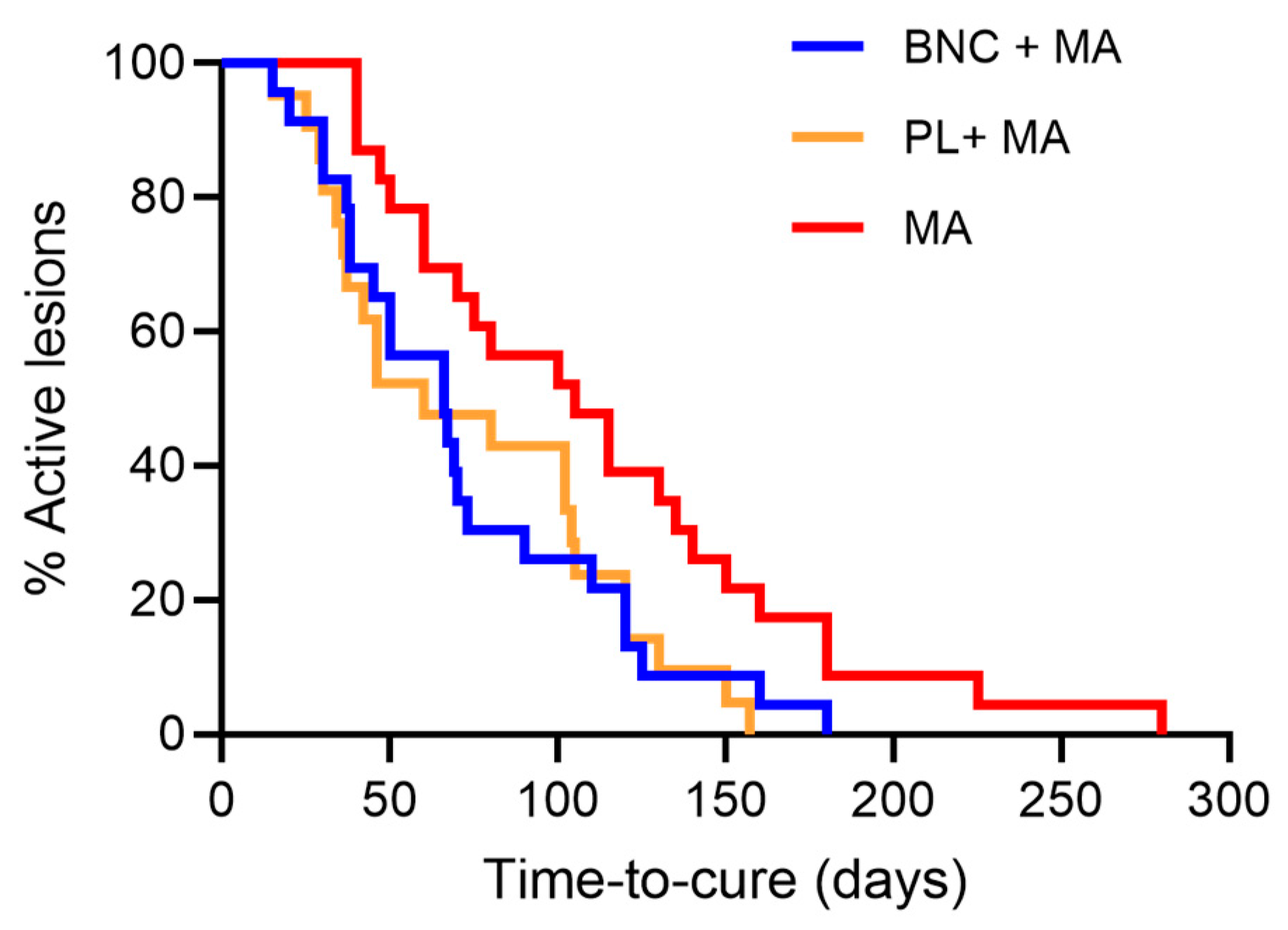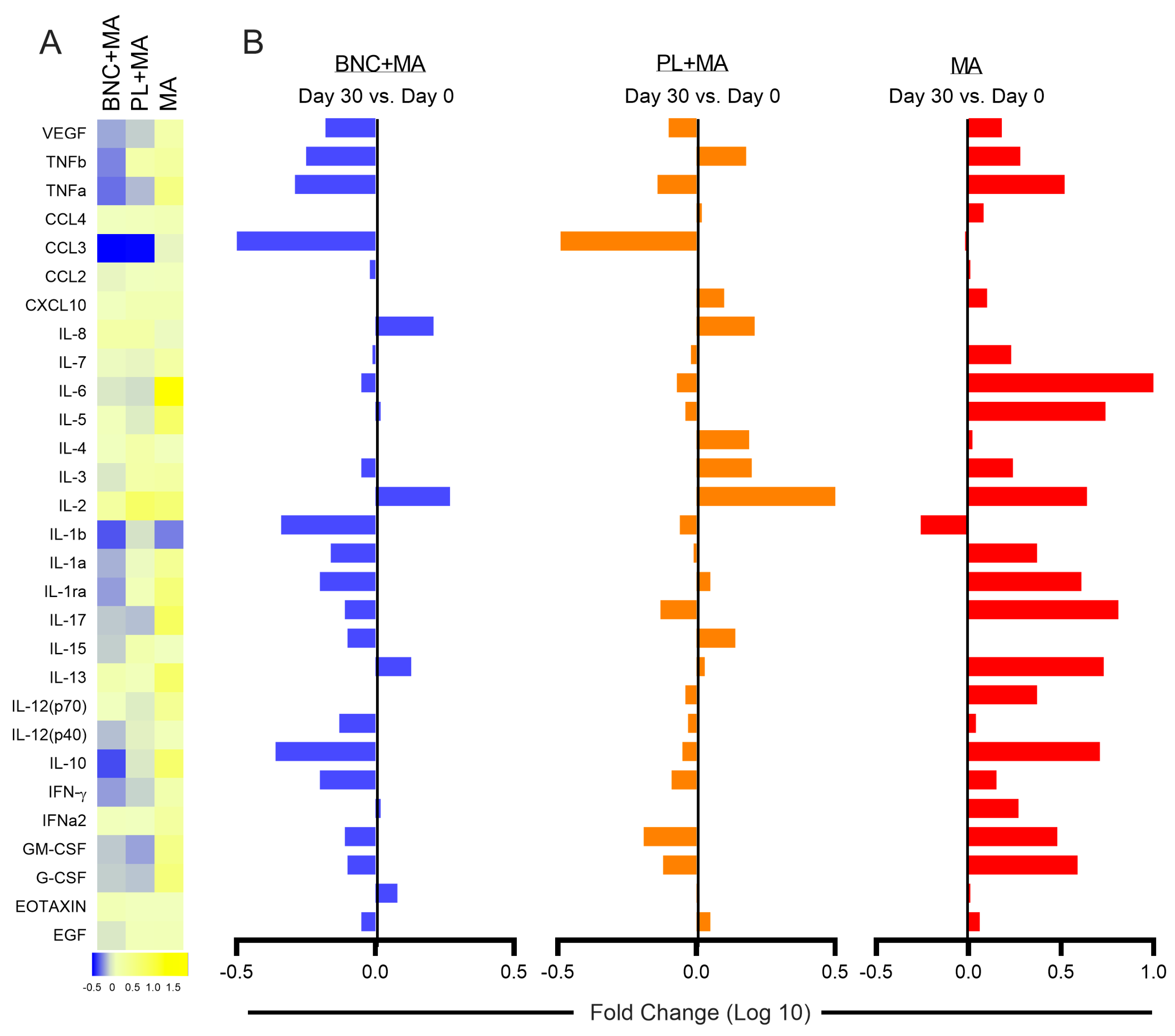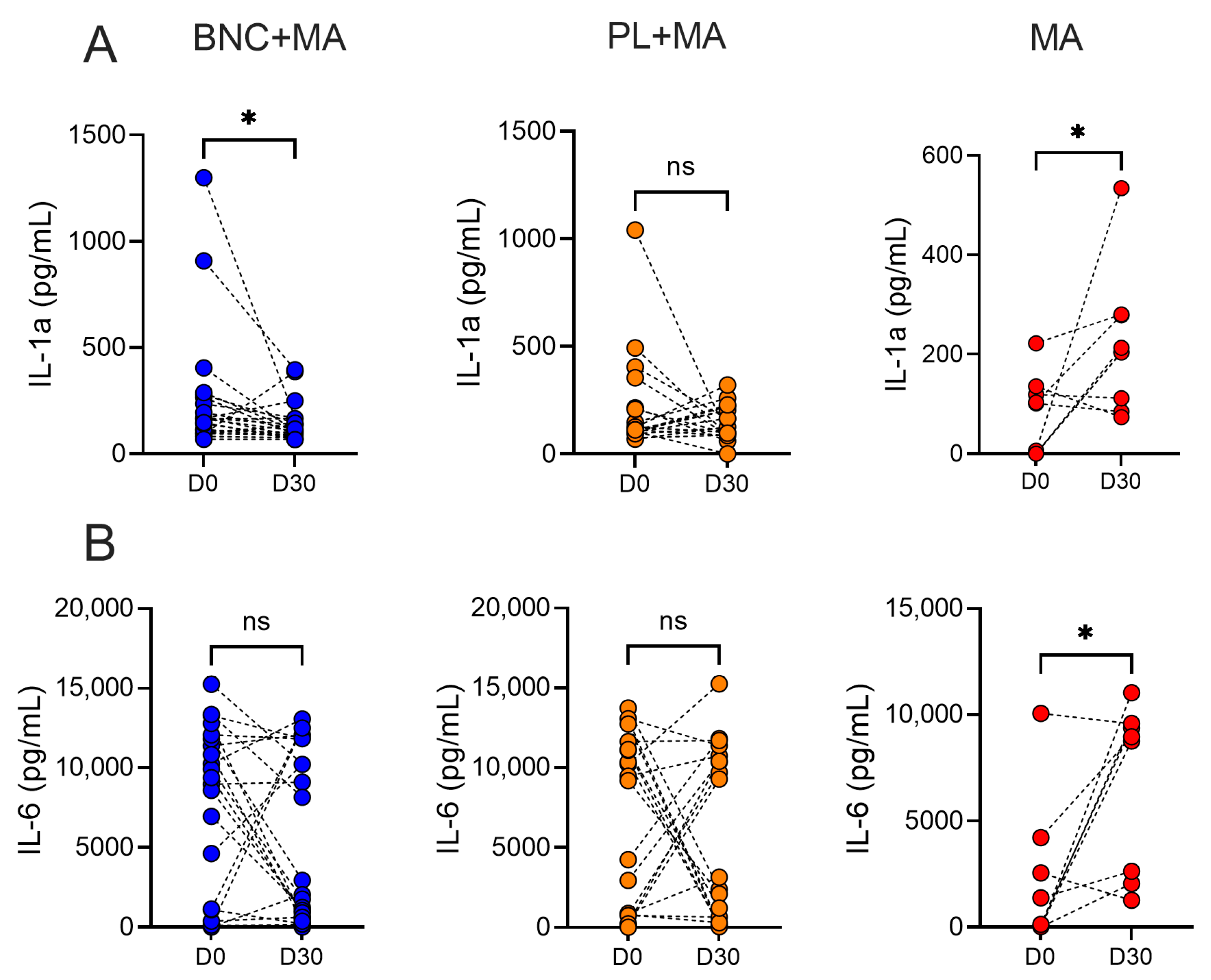Improved Treatment Outcome Following the Use of a Wound Dressings in Cutaneous Leishmaniasis Lesions
Abstract
1. Introduction
2. Materials and Methods
Statistical Analysis
3. Results
4. Discussion
5. Conclusions
Supplementary Materials
Author Contributions
Funding
Institutional Review Board Statement
Informed Consent Statement
Data Availability Statement
Conflicts of Interest
References
- Leishmaniasis—PAHO/WHO|Pan American Health Organization. Available online: https://www.paho.org/en/topics/leishmaniasis (accessed on 18 December 2023).
- Belo, V.S.; Bruhn, F.R.P.; Barbosa, D.S.; Câmara, D.C.P.; Simões, T.C.; Buzanovsky, L.P.; Duarte, A.G.S.; De Melo, S.N.; Cardoso, D.T.; Donato, L.E.; et al. Temporal Patterns, Spatial Risks, and Characteristics of Tegumentary Leishmaniasis in Brazil in the First Twenty Years of the 21st Century. PLoS Negl. Trop. Dis. 2023, 17, e0011405. [Google Scholar] [CrossRef] [PubMed]
- Machado, P.R.L.; Lessa, H.; Lessa, M.; Guimaraes, L.H.; Bang, H.; Ho, J.L.; Carvalho, E.M. Oral Pentoxifylline Combined with Pentavalent Antimony: A Randomized Trial for Mucosal Leishmaniasis. Clin. Infect. Dis. 2007, 44, 788–793. [Google Scholar] [CrossRef] [PubMed]
- Turetz, M.L.; Machado, P.R.; Ko, A.I.; Alves, F.; Bittencourt, A.; Almeida, R.P.; Mobashery, N.; Johnson, W.D., Jr.; Carvalho, E.M. Disseminated Leishmaniasis: A New and Emerging Form of Leishmaniasis Observed in Northeastern Brazil. J. Infect. Dis. 2002, 186, 1829–1834. [Google Scholar] [CrossRef] [PubMed]
- Brito, N.C.; Rabello, A.; Cota, G.F.; Fortin, A. Efficacy of Pentavalent Antimoniate Intralesional Infiltration Therapy for Cutaneous Leishmaniasis: A Systematic Review. PLoS ONE 2017, 12, e0184777. [Google Scholar] [CrossRef] [PubMed]
- Prates, F.V.D.O.; Dourado, M.E.F.; Silva, S.C.; Schriefer, A.; Guimarães, L.H.; Brito, M.D.G.O.; Almeida, J.; Carvalho, E.M.; Machado, P.R.L. Fluconazole in the Treatment of Cutaneous Leishmaniasis Caused by Leishmania Braziliensis: A Randomized Controlled Trial. Clin. Infect. Dis. 2017, 64, 67–71. [Google Scholar] [CrossRef] [PubMed][Green Version]
- Machado, P.R.; Ampuero, J.; Guimarães, L.H.; Villasboas, L.; Rocha, A.T.; Schriefer, A.; Sousa, R.S.; Talhari, A.; Penna, G.; Carvalho, E.M. Miltefosine in the Treatment of Cutaneous Leishmaniasis Caused by Leishmania Braziliensis in Brazil: A Randomized and Controlled Trial. PLoS Negl. Trop. Dis. 2010, 4, e912. [Google Scholar] [CrossRef]
- Sundar, S.; Chakravarty, J. Liposomal Amphotericin B and Leishmaniasis: Dose and Response. J. Glob. Infect. Dis. 2010, 2, 159. [Google Scholar] [CrossRef]
- Peixoto, F.; Nascimento, M.T.; Costa, R.; Silva, J.; Renard, G.; Guimarães, L.H.; Penna, G.; Barral-Netto, M.; Carvalho, L.P.; Machado, P.R.L.; et al. Evaluation of the Ability of Miltefosine Associated with Topical GM-CSF in Modulating the Immune Response of Patients with Cutaneous Leishmaniasis. J. Immunol. Res. 2020, 2020, 2789859. [Google Scholar] [CrossRef]
- Azim, M.; Khan, S.A.; Ullah, S.; Ullah, S.; Anjum, S.I. Therapeutic Advances in the Topical Treatment of Cutaneous Leishmaniasis: A Review. PLoS Negl. Trop. Dis. 2021, 15, e0009099. [Google Scholar] [CrossRef]
- Zhong, C.; Zhang, G.-C.; Liu, M.; Zheng, X.-T.; Han, P.-P.; Jia, S.-R. Metabolic Flux Analysis of Gluconacetobacter Xylinus for Bacterial Cellulose Production. Appl. Microbiol. Biotechnol. 2013, 97, 6189–6199. [Google Scholar] [CrossRef]
- Portela, R.; Leal, C.R.; Almeida, P.L.; Sobral, R.G. Bacterial Cellulose: A Versatile Biopolymer for Wound Dressing Applications. Microb. Biotechnol. 2019, 12, 586–610. [Google Scholar] [CrossRef] [PubMed]
- Sajjad, W.; Khan, T.; Ul-Islam, M.; Khan, R.; Hussain, Z.; Khalid, A.; Wahid, F. Development of Modified Montmorillonite-Bacterial Cellulose Nanocomposites as a Novel Substitute for Burn Skin and Tissue Regeneration. Carbohydr. Polym. 2019, 206, 548–556. [Google Scholar] [CrossRef] [PubMed]
- Picheth, G.F.; Pirich, C.L.; Sierakowski, M.R.; Woehl, M.A.; Sakakibara, C.N.; de Souza, C.F.; Martin, A.A.; da Silva, R.; de Freitas, R.A. Bacterial Cellulose in Biomedical Applications: A Review. Int. J. Biol. Macromol. 2017, 104, 97–106. [Google Scholar] [CrossRef] [PubMed]
- Celes, F.S.; Barud, H.S.; Viana, S.M.; Borba, P.B.; Machado, P.R.L.; Carvalho, E.M.; de Oliveira, C.I. A Pilot and Open Trial to Evaluate Topical Bacterial Cellulose Bio-Curatives in the Treatment of Cutaneous Leishmaniasis Caused by L. braziliensis. Acta Trop. 2022, 225, 106192. [Google Scholar] [CrossRef] [PubMed]
- Weirather, J.L.; Jeronimo, S.M.B.; Gautam, S.; Sundar, S.; Kang, M.; Kurtz, M.A.; Haque, R.; Schriefer, A.; Talhari, S.; Carvalho, E.M.; et al. Serial Quantitative PCR Assay for Detection, Species Discrimination, and Quantification of Leishmania spp. in Human Samples. J. Clin. Microbiol. 2011, 49, 3892–3904. [Google Scholar] [CrossRef] [PubMed]
- Muangman, P.; Opasanon, S.; Suwanchot, S.; Thangthed, O. Efficiency of Microbial Cellulose Dressing in Partial-Thickness Burn Wounds. J. Am. Coll. Certif. Wound Spec. 2011, 3, 16–19. [Google Scholar]
- Silva, L.G.; Albuquerque, A.V.; Pinto, F.C.M.; Ferraz-Carvalho, R.S.; Aguiar, J.L.A.; Lins, E.M. Bacterial Cellulose an Effective Material in the Treatment of Chronic Venous Ulcers of the Lower Limbs. J. Mater. Sci. Mater. Med. 2021, 32, 79. [Google Scholar] [CrossRef] [PubMed]
- Salgado, V.R.; de Queiroz, A.T.; Sanabani, S.S.; de Oliveira, C.I.; Carvalho, E.M.; Costa, J.M.; Barral-Netto, M.; Barral, A. The microbiological signature of human cutaneous leishmaniasis lesions exhibits restricted bacterial diversity compared to healthy skin. Mem. Inst. Oswaldo Cruz 2016, 111, 241–251. [Google Scholar] [CrossRef] [PubMed]
- Farias Amorim, C.; Lovins, V.M.; Singh, T.P.; Novais, F.O.; Harris, J.C.; Lago, A.S.; Carvalho, L.P.; Carvalho, E.M.; Beiting, D.P.; Scott, P.; et al. Multiomic Profiling of Cutaneous Leishmaniasis Infections Reveals Microbiota-Driven Mechanisms Underlying Disease Severity. Sci. Transl. Med. 2023, 15, eadh1469. [Google Scholar] [CrossRef]
- Barakat, R.; Aronson, N.; Olsen, C. Microbiome Manipulation: Antibiotic Effects on Cutaneous Leishmaniasis Presentation and Healing. Open Forum Infect. Dis. 2017, 4 (Suppl. S1), S122. [Google Scholar] [CrossRef][Green Version]
- Sosa, N.; Pascale, J.M.; Jiménez, A.I.; Norwood, J.A.; Kreishman-Detrick, M.; Weina, P.J.; Lawrence, K.; McCarthy, W.F.; Adams, R.C.; Scott, C.; et al. Topical Paromomycin for New World Cutaneous Leishmaniasis. PLoS Negl. Trop. Dis. 2019, 13, e0007253. [Google Scholar] [CrossRef] [PubMed]
- Ben Salah, A.; Ben Messaoud, N.; Guedri, E.; Zaatour, A.; Ben Alaya, N.; Bettaieb, J.; Gharbi, A.; Belhadj Hamida, N.; Boukthir, A.; Chlif, S.; et al. Topical Paromomycin with or without Gentamicin for Cutaneous Leishmaniasis. N. Engl. J. Med. 2013, 368, 524–532. [Google Scholar] [CrossRef] [PubMed]
- Voronov, E.; Dotan, S.; Gayvoronsky, L.; White, R.M.; Cohen, I.; Krelin, Y.; Benchetrit, F.; Elkabets, M.; Huszar, M.; El-On, J.; et al. IL-1-Induced Inflammation Promotes Development of Leishmaniasis in Susceptible BALB/c Mice. Int. Immunol. 2010, 22, 245–257. [Google Scholar] [CrossRef] [PubMed][Green Version]
- Novais, F.O.; Carvalho, A.M.; Clark, M.L.; Carvalho, L.P.; Beiting, D.P.; Brodsky, I.E.; Carvalho, E.M.; Scott, P. CD8+ T Cell Cytotoxicity Mediates Pathology in the Skin by Inflammasome Activation and IL-1β Production. PLOS Pathog. 2017, 13, e1006196. [Google Scholar] [CrossRef]
- Santos, D.; Campos, T.M.; Saldanha, M.; Oliveira, S.C.; Nascimento, M.; Zamboni, D.S.; Machado, P.R.; Arruda, S.; Scott, P.; Carvalho, E.M.; et al. IL-1β Production by Intermediate Monocytes Is Associated with Immunopathology in Cutaneous Leishmaniasis. J. Investig. Dermatol. 2018, 138, 1107–1115. [Google Scholar] [CrossRef] [PubMed]
- Carvalho, A.M.; Bacellar, O.; Carvalho, E.M. Protection and Pathology in Leishmania Braziliensis Infection. Pathogens 2022, 11, 466. [Google Scholar] [CrossRef]
- Lessa, H.A.; Machado, P.; Lima, F.; Cruz, A.A.; Bacellar, O.; Guerreiro, J.; Carvalho, E.M. Successful Treatment of Refractory Mucosal Leishmaniasis with Pentoxifylline plus Antimony. Am. J. Trop. Med. Hyg. 2001, 65, 87–89. [Google Scholar] [CrossRef] [PubMed]
- Novais, F.O.; Nguyen, B.T.; Scott, P. Granzyme B Inhibition by Tofacitinib Blocks the Pathology Induced by CD8 T Cells in Cutaneous Leishmaniasis. J. Investig. Dermatol. 2021, 141, 575–585. [Google Scholar] [CrossRef] [PubMed]
- Solway, D.R.; Clark, W.A.; Levinson, D.J. A Parallel Open-Label Trial to Evaluate Microbial Cellulose Wound Dressing in the Treatment of Diabetic Foot Ulcers. Int. Wound J. 2011, 8, 69–73. [Google Scholar] [CrossRef]
- Pan, X.; Han, C.; Chen, G.; Fan, Y. Evaluation of Bacterial Cellulose Dressing versus Vaseline Gauze in Partial Thickness Burn Wounds and Skin Graft Donor Sites: A Two-Center Randomized Controlled Clinical Study. Evid. Based Complement. Alternat. Med. 2022, 2022, 5217617. [Google Scholar] [CrossRef]



| Characteristic | BNC+MA (N = 25) | PL+MA (N = 21) | MA (N = 23) | BNC+MA vs. PL+MA vs. MA | BNC+MA vs. PL+MA | MA vs. BNC+MA | MA vs. PL+MA |
|---|---|---|---|---|---|---|---|
| Age, Years & | 23 (18–40) | 29 (21–38) | 30 (22–35) | ns # | ns ¶ | ns ¶ | ns ¶ |
| Sex, Male, n/N (%) | 18/25 (72%) | 13/21 (62%) | 16/23 (70%) | ns § | ns § | ns § | ns § |
| LST, mm2 | 196 (115–255) | 225 (155–225) | 180 (120–225) | ns # | ns ¶ | ns ¶ | ns ¶ |
| Illness duration, days & | 30(30–38) | 30 (30–43) | 30 (30–45) | ns # | ns ¶ | ns ¶ | ns ¶ |
| Size of largest lesion, mm2 & | 264 (154–536) | 240 (100–498) | 300 (220–480) | ns # | ns ¶ | ns ¶ | ns ¶ |
| Ulcers on lower limbs, n/N (%) | 18/25 (72%) | 13/21 (62%) | 20/23 (87%) | ns § | ns § | ns § | ns § |
| Lymphadenopathy, n/N (%) | 19/25 (76%) | 15/21 (71%) | 13/23 (57%) | ns § | ns § | ns § | ns § |
| Response to Therapy, n/N (%) | BNC+MA (N = 25) | PL+MA (N = 21) | MA (N = 23) | BNC+MA vs. PL+MA vs. MA | BNC+MA vs. PL+MA | BNC+ MA vs. MA | PL+ MA vs. MA |
|---|---|---|---|---|---|---|---|
| Cure at D30 | 3/25 (12%) | 3/21(14%) | 0/23 (0%) | ns § | ns § | ns § | ns § |
| Cure at D60 | 11/25 (44%) | 10/21(48%) | 7/23 (30%) | ns § | ns § | ns § | ns § |
| Cure at D90 | 17/25 (68%) | 12/21(57%) | 10/23 (44%) | ns § | ns § | ns § | ns § |
| Rescue therapy | 8/25 (32%) | 9/21 (43%) | 13/23 (57%) | ns § | ns § | ns § | ns § |
| Time-to-heal, days (median, IQR) | 66 (38–110) | 60 (35–113) | 105 (60–150) | 0.025 # | ns ¶ | 0.019 ¶ | 0.026 ¶ |
Disclaimer/Publisher’s Note: The statements, opinions and data contained in all publications are solely those of the individual author(s) and contributor(s) and not of MDPI and/or the editor(s). MDPI and/or the editor(s) disclaim responsibility for any injury to people or property resulting from any ideas, methods, instructions or products referred to in the content. |
© 2024 by the authors. Licensee MDPI, Basel, Switzerland. This article is an open access article distributed under the terms and conditions of the Creative Commons Attribution (CC BY) license (https://creativecommons.org/licenses/by/4.0/).
Share and Cite
Borba, P.B.; Lago, J.; Lago, T.; Araújo-Pereira, M.; Queiroz, A.T.L.; Barud, H.S.; Carvalho, L.P.; Machado, P.R.L.; Carvalho, E.M.; de Oliveira, C.I. Improved Treatment Outcome Following the Use of a Wound Dressings in Cutaneous Leishmaniasis Lesions. Pathogens 2024, 13, 416. https://doi.org/10.3390/pathogens13050416
Borba PB, Lago J, Lago T, Araújo-Pereira M, Queiroz ATL, Barud HS, Carvalho LP, Machado PRL, Carvalho EM, de Oliveira CI. Improved Treatment Outcome Following the Use of a Wound Dressings in Cutaneous Leishmaniasis Lesions. Pathogens. 2024; 13(5):416. https://doi.org/10.3390/pathogens13050416
Chicago/Turabian StyleBorba, Pedro B., Jamile Lago, Tainã Lago, Mariana Araújo-Pereira, Artur T. L. Queiroz, Hernane S. Barud, Lucas P. Carvalho, Paulo R. L. Machado, Edgar M. Carvalho, and Camila I. de Oliveira. 2024. "Improved Treatment Outcome Following the Use of a Wound Dressings in Cutaneous Leishmaniasis Lesions" Pathogens 13, no. 5: 416. https://doi.org/10.3390/pathogens13050416
APA StyleBorba, P. B., Lago, J., Lago, T., Araújo-Pereira, M., Queiroz, A. T. L., Barud, H. S., Carvalho, L. P., Machado, P. R. L., Carvalho, E. M., & de Oliveira, C. I. (2024). Improved Treatment Outcome Following the Use of a Wound Dressings in Cutaneous Leishmaniasis Lesions. Pathogens, 13(5), 416. https://doi.org/10.3390/pathogens13050416









